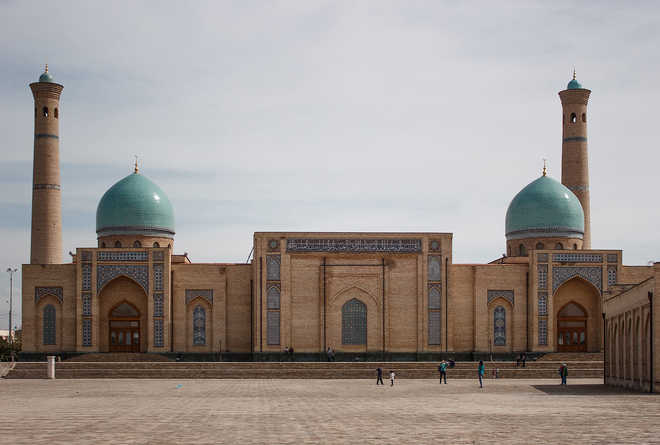
Cradle of cultures: Hazrati Imam madrasa has handwritten copies of the Koran dating back to the seventh century Photos by the writer
Ranjit Powar
Not many travellers would fancy Uzbekistan as a travel destination but this Central Asian land of vast Steppes and the Great Silk Road holds many a treasure. Besides the allure of the azure and turquoise domes and minarets of Timur’s Samarkand and Bukhara, there exists an intriguing Indian link to this region. Babur, the founder of Mughal dynasty in India, belonged to the Fergana valley in Uzbekistan. Though this region was populated by Iranians, Arabs, Turks, Greeks and Mongol raiders at different times, it was also occupied by a martial, horse-riding people called the Scythians. They were expert archers and warriors and invaded Afghanistan and North India between the fourth century BC and sixth century AD, settling in the modern-day Swat, Punjab, Haryana, Rajasthan and Gujarat. DNA matches have indicated that the present-day Jats, Gujjars, Rajputs, Lohar and Tarkhan communities have descended from these Indo-Scythian tribes.
Uzbeks are a handsome mix of the many races, which invaded the grasslands at different times and integrated with the local population. The people are mostly fair, with broad faces. The Russian regime has left a huge cultural influence with the majority being liberal Muslims. Most women wear western dresses. Dubbed Indian films are very popular and people love Bollywood songs. Pulao is the national dish and somsa, bread, salad and lagman, a mixed broth of meat and vegetables. Melons, grapes, peaches, plums and dry fruits are in abundance.
Tashkent is the port of entry to Uzbekistan. Rebuilt after a massive earthquake in 1966, it is a modern city with wide, well-laid out boulevards and high-rise apartments. The city is clean, open and green with no slums and beggars in sight.
Hazrati Imam madrasa, with handwritten copies of the Koran dating back to the seventh century, Abul Kasim Madrasah, Anar Bibi Mausoleum, Juma Mosque are some of the many historical places in Tashkent. A bullet train, Afrasiyab, connects Tashkent with Samarkand. The railway station is beautiful, laid out with fountains and flowerbeds and relief work on the walls.
The Samarkand city holds the mausoleum of Amir Timur, a celebrated national hero in Uzbekistan. The city centre has an exotic area surrounded with gardens and called the Registan Square. It has three huge and majestic madrasas in the grand Oriental architecture, placing Samarkand in the Unesco World Heritage List. Though Russians prohibited all religious activity after taking over in 1917, they helped restore many historical sites.
Most historical places have several shops where artisans can be seen working on artefacts like miniature paintings, suzani embroidery pieces, wood engravings, ceramics, carpets, rugs and ikkat fabric.
Shahrisabz, meaning the “green city” falls between Samarkand and Bukhara, deriving its importance from being the birthplace of Timur. The walled city has remains of the Ak saray palace and old mosques overlooked by a huge statue of Timur.
Bukhara, founded in the 13th century AD, is a holy city of Muslims. A major trade centre on the Silk Road, it is a “town museum” with 140 monuments dating back to the Middle Ages. Among the important ones are Mir-e-Arab madrasa, Ulugh Beg mosque, Samani mausoleum and the Bukhara Ark, the city fortress.
The landscape one sees travelling between cities consists of huge expanses of dry, grassy steppes with shrubs and distant villages comprising small tin-roofed cottages and a lone donkey-driven cart. These vast arid expanses have little cultivation as these depend solely on rain for irrigation, except in places near the river Amu and Syr Darya.
Khiva is a 2500-year-old city and a centre of Islam with an array of madrasas and mosques and an inner town, Ichan Kala. Built in the 10th century, the city is encircled by a broad mud wall and has brilliantly restored narrow paved lanes and mud-brick old buildings. The Djuma mosque, with 112 carved elm wood columns, has stood through centuries of witnessing the Zoroastrians pray to fire and the Muslims kneel to Allah. Part of the ancient Silk Road is still intact here, its huge boulders marked with ruts from centuries of horse-driven carriages rattling over them. Its dubious distinction of being one of the major slave markets of Central Asia continued till as late as 1917, when slavery was formally abolished.
Uzbekistan is a treasure trove for history buffs who would like to walk over parts of the Great Silk Road resounding with footsteps of travellers through the centuries.
Fact File
Getting there: Uzbekistan Airways runs a direct three-hour flight from New Delhi to Tashkent.
Best season: April to May and September end to early November.



























